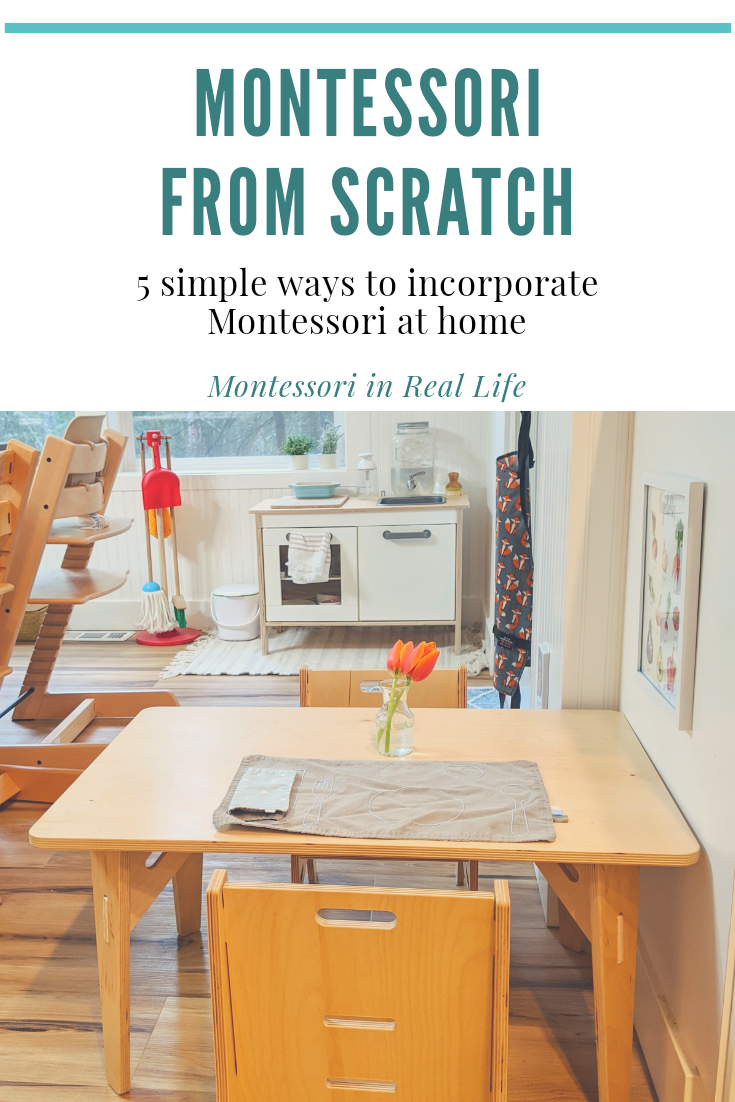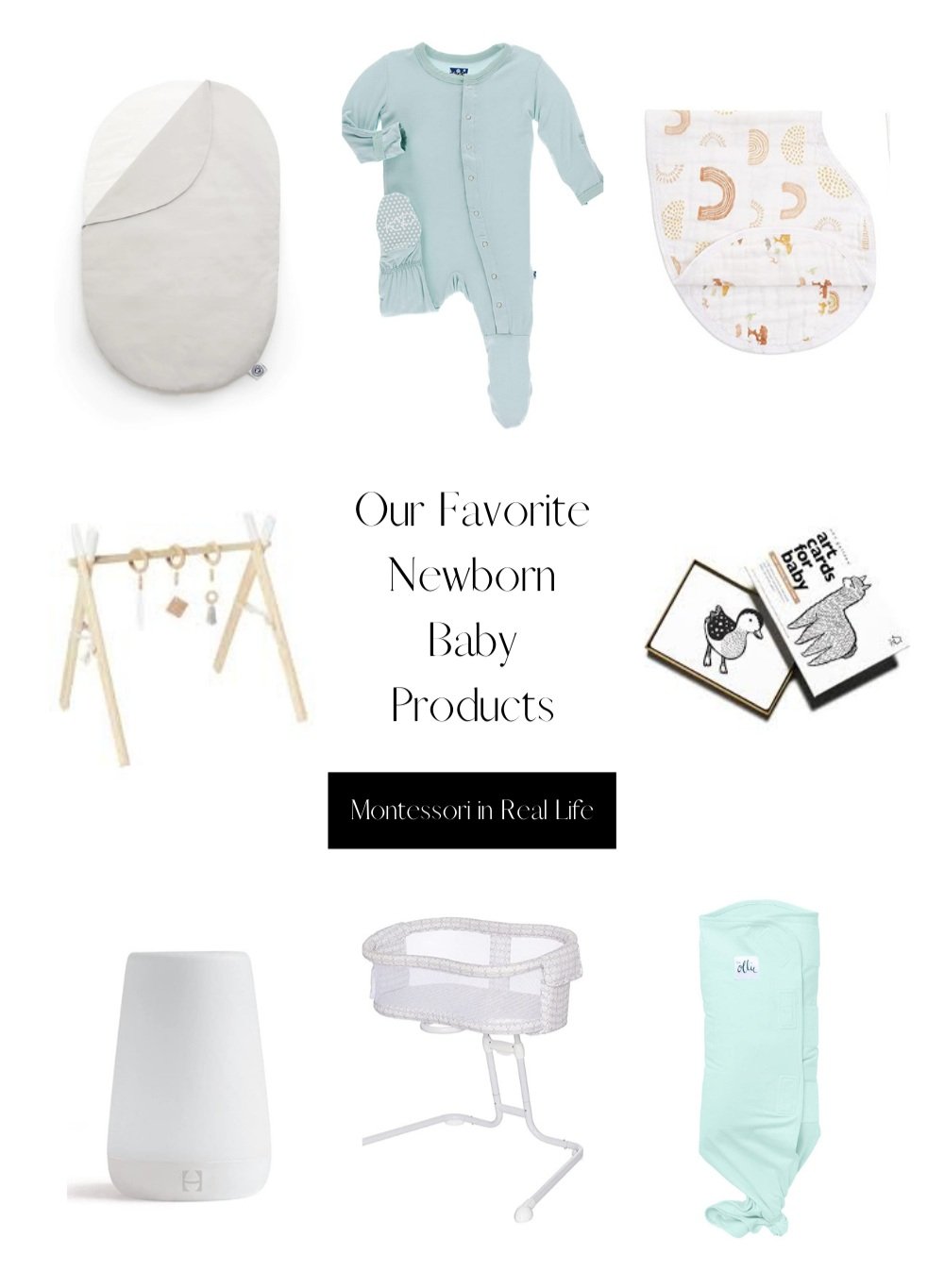Montessori from Scratch
Montessori in Real Life
I often get the question, “I want to incorporate Montessori at home but how do I start?” There is so much out there about Montessori these days that it can be overwhelming to even know where to begin. My hope is that this blog post gives you a few ideas of how to incorporate Montessori at home, beyond the fancy Montessori materials.
Allow for Free Movement
Set up your home or a room(s) in your home where your baby or child is free to explore without constant supervision, saying “No!”, or fear of getting into something unsafe. Janet Lansbury calls this a “yes space”. This could be a playroom, your living room, or most of the house. I find it’s easiest to baby or child-proof the whole living area as well as the kitchen/dining area, as that’s where we spend the time as a family. Keep unsafe items out of reach or in baby-proofed cabinets, while leaving other shelves and drawers open with toys or safe household items for them to explore. If they need to climb, provide safe furniture, cushions, or climbing toys that you can redirect them to. We want our children to feel like a part of the family, so we typically avoid confined play pens and instead, allow (limited) free range.
Observe and Rotate
Giant bins of toys or sheer number of toys can be overstimulating for many babies and children. Rather than put out all your toys at once, observe what your child uses and ignores, and rotate materials accordingly. Rotating also makes old toys new again, which helps to keep your child engaged. While some materials may always stay available, such as blocks, vehicles, and/or dolls, most can be rotated in and out. Find a closet where you can store materials and toys not currently being used, and place 8-12 materials on a low shelf or bookcase for your child to explore. By observing your child with materials, you can learn a lot about their development, abilities, and interests. How often you rotate depends on your child’s interest in the materials and how often you are home, but I tend to rotate about half the materials every 2-3 weeks.
Provide Opportunities for Independence
Try to imagine you are your child's size. What would you need to be able to accomplish a task yourself? Does your child have a way to reach the sink to wash their hands? Can they pick out their own socks and shoes? Is there a mirror at their level to see themselves when they dress? Do they have access to washcloths to wipe up spills? Any small task to you is an important and meaningful task to a toddler. They feel so empowered when we give them these small opportunities for independence. For babies, think about ways they can freely move, access their own toys, or feed themselves.
Be Your Child’s Guide
There is a reason Montessori teachers are called Guides. The child is in charge of their own learning, and the adult is there to help guide and support the child. Rather than always telling your child what to do, give them a chance to work through tasks and problems themselves. Only step in when they ask for your help. When they do need help, offer prompting questions such as "Where do you think that goes?" or "What comes next?" rather than automatically doing it for them. When modeling something new, slow way down and emphasize your actions while using few words, so they are able to watch and learn from you. Guiding also means getting down to the child's level and speaking to them gently in a way they understand. It helps to remember that the way we talk to our children is the way they will talk to others.
Offer Real Tasks and Tools
While toys are wonderful (and just so beautiful!), often babies’ and toddlers’ favorite activities are regular household items and activities. Babies love kitchen utensils, brushes, keys, and cords more than anything. Toddlers love washing windows, making snack, doing dishes, and sorting laundry way more than we do. Involve them in household tasks with you, or let them try by themselves. The more “real” the task and the tools we give them, the more capable, confident, and joyful they are. We show them respect and belonging in our family when we give them glasses and dishes rather than sippy cups and plastic. They may not be as careful or complete as we are, but the effort and enthusiasm they put in is admirable and worth celebrating. Mastery comes with a lot of practice and patience.
It may also help to read my posts, What is Montessori for infants and toddlers?, Praise vs. Acknowledgment, Montessori for Grandparents and Caregivers, and Montessori on a Budget for more broad overviews. If you have an infant or toddler, you might also find the monthly Montessori Guides helpful, for Montessori materials and activity suggestions month by month.
















